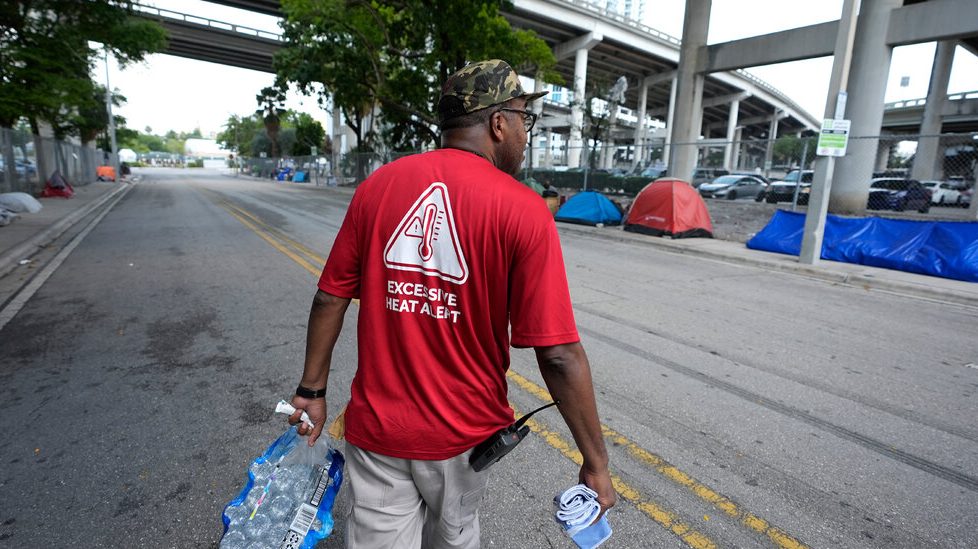‘Insane’ Heat Has Been Scorching Miami. It’s Not Even June.

Meteorologists in Miami, it is fair to say, are accustomed to drama: sunny-day flooding, severe rainstorms, strong hurricanes.
So it is telling — and scary — that they seem at a loss for words to describe the extreme heat that the city experienced over the past few days, a full month ahead of summer.
“It’s completely crazy, what just happened,” Brian McNoldy, a senior research scientist at the University of Miami, said.
“It’s insane,” said John Morales, a meteorologist for ClimaData, a private weather forecasting and consulting firm, and a hurricane specialist at WTVJ-TV, the NBC station in Miami. “Not only is it insane, it is also dangerous.”
They were talking about the heat index, a measure of how hot it really feels outside, taking into account humidity along with temperature. The heat index reached 112 degrees on both Saturday and Sunday, breaking the previous daily record by an astonishing 11 degrees.
Sunday’s high of 96 degrees was also record-breaking, Mr. McNoldy said. Saturday’s high of 94 was one degree shy of that day’s record. All of this in May, normally a sufferable month in Miami compared with the three or four that follow.
“Even if they happened at what is normally the most uncomfortable part of the year,” Mr. McNoldy said, referring to the first two weeks of August, “those days would have been extraordinary.”
Last year was the hottest in Florida since 1985, with coastal waters reaching 90 degrees, bleaching coral and possibly contributing to the mysterious deaths of endangered sawfish. This year, forecasters expect an exceptionally high number of hurricanes, in part because the Atlantic Ocean has remained abnormally warm.
Increasingly extreme weather, including stronger hurricanes and worsening floods, have led to the withdrawal of major insurers from the state and to some of the highest insurance premiums in the country.
Now, extreme heat appears to be reshaping shoulder seasons, too. The heat index in Key West, about 160 miles south of Miami, reached 115 degrees on May 15, according to Mr. McNoldy, shattering the previous record by 17 degrees.
South Florida is warm and humid much of the year, but only rarely does (or did) the air temperature reach the mid-90s. What turns the region’s heat dangerous is when high temperatures combine with very high humidity, which can make it feel oppressively hot.
That is how it went over the weekend. Stepping outdoors felt like walking into a broiler, even well into the night. Taking three showers a day was not out of the question. On Sunday, people packed a beach in Key Biscayne, a barrier island just east of Miami, where the water felt more like deep summer than late spring.
Last week Gov. Ron DeSantis, a Republican who has backed programs to make communities more resilient to extreme weather, signed legislation deleting many mentions of climate change from Florida policy — in one of the states most vulnerable to climate change.
On Saturday, Steve MacLaughlin, a meteorologist for WTVJ, urged viewers to weigh elected leaders’ decisions while experiencing punishing temperatures.
“The entire world is looking to Florida to lead in climate change, and our government is saying that climate change is no longer the priority it once was,” he said.
“Please keep in mind the most powerful climate change solution is the one you already have in the palm of your hands: the right to vote,” Mr. MacLaughlin added. “We will never tell you who to vote for, but we will tell you this: We implore you to please do your research and know that there are candidates that believe in climate change, and that there are solutions — and there are candidates that don’t.”
Last month, Mr. DeSantis enacted a law banning local governments from requiring employers to provide heat protections, after Miami-Dade County came close to adopting the nation’s strictest requirements for providing outdoor workers with water, rest and shade.
Esteban Wood, the policy director for WeCount, which represents farmworkers, plant nursery workers and construction workers in Miami-Dade County and pushed for the protections, said that the spring is the peak season for tropical plant horticulture and did not typically coincide with extreme heat.
“Now, it does,” he said. “We are seeing temperatures that these workers have never seen in their lives.”
By Tuesday afternoon, thunderstorms began rolling across Miami. They felt like a respite.
The post ‘Insane’ Heat Has Been Scorching Miami. It’s Not Even June. appeared first on New York Times.
